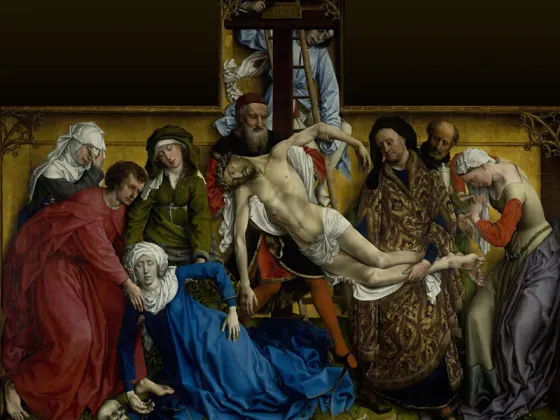
高清大图局部细节 / DETAILS
作品简介
——这幅小画中的模特身穿一件宽大的白色亨宁衫,外面套着一件棕色连衣裙,连衣裙的 V 形领口带有黑色线条。与罗吉尔·凡·德尔·维登的女性肖像画中常见的情形一样,她的双手紧握,祈祷着,表情通常很谦卑。与凡·德·维登的画作不同,她没有低头或凝视中间距离。相反,她直视观众,在模特、观众和艺术家之间建立了一种亲密的关系,艺术史学家兼研究策展人洛恩·坎贝尔 (Lorne Campbell) 将其描述为“有吸引力且充满活力”。
模特儿有一双异常明亮、大而迷人的蓝眼睛;这双眼睛的呈现可能被认为不符合当代表现手法,因为艺术家没有缩小模特儿左眼的尺寸来反映她向观者左侧转动头部的幅度。她从画布上方观者右侧的光源获得照明,这营造出落下的光线,使她面纱和皮肤的鲜白色与她衣服和头部的深色色调形成鲜明对比。
这幅画由水平线和垂直线混合构成。头饰的垂直线与肩膀和胸部的线条融为一体,面纱的水平褶皱与上下嘴唇形成的线条形成鲜明对比。鉴于她五官的个性,罗吉尔显然是在对一个真实人物的生活研究的基础上创作的。然而,画中也不乏抽象的元素。从模特相对朴素的衣着、主妇般的面容和突出的胸部来看,她很可能是中产阶级的一员。人们普遍认为她是以艺术家的妻子伊丽莎白·戈法特为原型创作的,尽管这一点尚未得到证实。这幅肖像与罗吉尔和罗伯特·坎平的其他女性肖像相似。事实上,罗吉尔和坎平的女性肖像画如此相似,以至于有时被误认为是他们的作品。
Portrait of a Young Woman(orLady Wearing a Gauze Headdress) is a painting completed between 1435–1440 by theNetherlandishartistRogier van der Weyden.
The sitter in this small work wears a wide, whitehenninover a brown dress, which features a black-lined, v-shaped neckline. As is usual of van der Weyden's female portraits, her hands are clasped tightly in prayer, while her expression is generally humble. Unusually for a van der Weyden', she does not bow her head or gaze into the middle distance. Instead she looks directly at the viewer, creating an intimate relationship between sitter, viewer and artist,which art historian and research curator Lorne Campbell describes as "appealing and vibrant".
The sitter has unusually bright, large and attractive blue eyes; their rendering may be considered outside of contemporary representation in that the artist did not reduce the size of the sitter's left eye to reflect the scale of her turn of head to the viewer's left. She is lit from a source above the canvas to the viewer's right, which sets up the falling light used to contrast the vivid white of her veil and flesh against the dark tones of her dress and volume of her head.
The painting is composed through a mix of horizontal and vertical lines. The verticals of her head-dress blend into the lines of her shoulders and chest, while the horizontal folds of the veil are set against the line formed by her upper and lower lips. Given the individuality of her features, Rogier was obviously working from a life study of an actual person. Yet there are elements of abstraction in the image.The model is likely a member of the middle class, given her relatively plain dress, matronly features and accentuated breasts.It is widely believed that she was modeled on the artist's wife,Elisabeth Goffaert, though this has not been proven.The portrait is similar to other female portraits by Rogier andRobert Campin. In fact, the similarity between Rogier's and Campin's female portraits is so strong that they were sometimes mis-attributed.
















